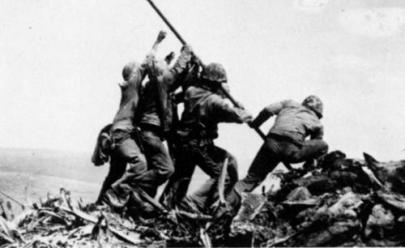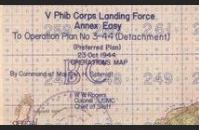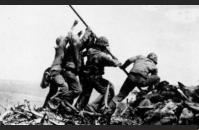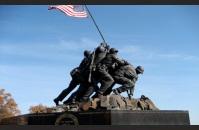IWO JIMA AT A GLANCE:

Image Gallery
The Battle for Iwo Jima
Location: Volcanic island 660 miles south of Tokyo
Size: 2 miles wide by 4 miles long (8 sm)
Background: Summer/Fall 1944
Even before ground operations to secure the Mariana Islands of Guam, Saipan, and Tinian ended, U.S. Naval construction battalions were already clearing land for air bases suitable for the new B-29 “Superfortresses.” These huge bombers had a range capable of reaching the Japanese Home Islands. The first B-29 bombing runs began in October 1944. But there was a problem—Japanese fighters taking off from tiny Iwo Jima were intercepting B-29s, as well as attacking the Mariana airfields. The U.S. determined that Iwo Jima must be captured.
The Battle: U.S. Marines invaded Iwo Jima on February 19, 1945, after months of naval and air bombardment. The Japanese defenders of the island were dug into bunkers deep within the volcanic rocks. Approximately 70,000 U.S. Marines and 18,000 Japanese soldiers took part in the battle. In thirty-six days of fighting on the island, nearly 7,000 U.S. Marines were killed. Another 20,000 were wounded. Marines captured only 216 Japanese soldiers; the rest were killed in action. The island was finally declared secured on March 16, 1945. It had been one of the bloodiest battles in Marine Corps history.
After the battle, Iwo Jima served as an emergency landing site for more than 2,200 B-29 bombers, saving the lives of 24,000 U.S. airmen. Securing Iwo Jima prepared the way for the last and largest battle in the Pacific: the invasion of Okinawa.
The Flag Raising: The flag-raising on Mt. Suribachi took place on February 23, 1945; five days after the battle began. To signal to American troops that the mountain had been secured, a task force raised a small flag atop Mt. Suribachi. But the flag was too small to be seen on the beaches below. So a second group of men, with a larger flag, were sent up the mountain. Associated Press photographer Joe Rosenthal took the famous photograph of six men raising this flag. The flag raisers were Corporal Harlon Block, Private First Class Harold Schultz, Corporal Rene Gagnon, Private First Class Franklin Sousley, Sergeant Michael Strank, and Corporal Ira Hayes. Three of these men—Strank, Sousley, and Block—were killed before the battle for Iwo Jima was over.
The photograph was quickly wired around the world and reproduced in newspapers across the United States. The image was used on postage stamps, War Bond posters, and as the model for the Marine Memorial near Arlington National Cemetery.
Note: Schultz’s participation in the flag raising and iconic photo was not officially recognized until June 2016, when the US Marine Corps announced that Navy Pharmacist Mate 2nd Class John Bradley had long been incorrectly identified as one of the men in the image captured by Rosenthal. Historian and author Richard Frank addressed the context in which such a misidentification could occur in an essay for The National WWII Museum’s online blog:
Ultimately, as the Marine Corps Commandant correctly affirmed, “It’s not about the individuals and never has been.” It is impossible to distinguish the faces of any of the flag raisers in the image. The power of the image is and always will be the stunning symbolism of collective effort and valor.
Awards: Twenty-seven Medals of Honor (the American military’s highest award for bravery) were awarded for action on Iwo Jima—more than any other battle in Marine Corps history.
"Among the men who fought on Iwo Jima, uncommon valor was a common virtue"
—U.S. Admiral Chester Nimitz
Download a printable version of this At A Glance
TAKE ACTION:


EDUCATION PROJECTS:
Student Travel – WWII Educational Tours
High school and college students, learn the leadership principles that helped win WWII on a trip to France or during a weeklong residential program in New Orleans. College credit is available, and space is limited.
See You Next Year! HS Yearbooks from WWII
Collected from across the United States, the words and pictures of these yearbooks present a new opportunity to experience the many challenges, setbacks and triumphs of the war through the eyes of America’s youth.
The Victory Gardens of WWII
Visit the Classroom Victory Garden Project website to learn about food production during WWII, find lesson plans and activities for elementary students, get tips for starting your own garden and try out simple Victory Garden recipes!
The Science and Technology of WWII
Visit our new interactive website to learn about wartime technical and scientific advances that forever changed our world. Incorporates STEM principles to use in the classroom.
Kids Corner: Fun and Games!
Make your own propaganda posters, test your memory, solve puzzles and more! Learn about World War II and have fun at the same time.






